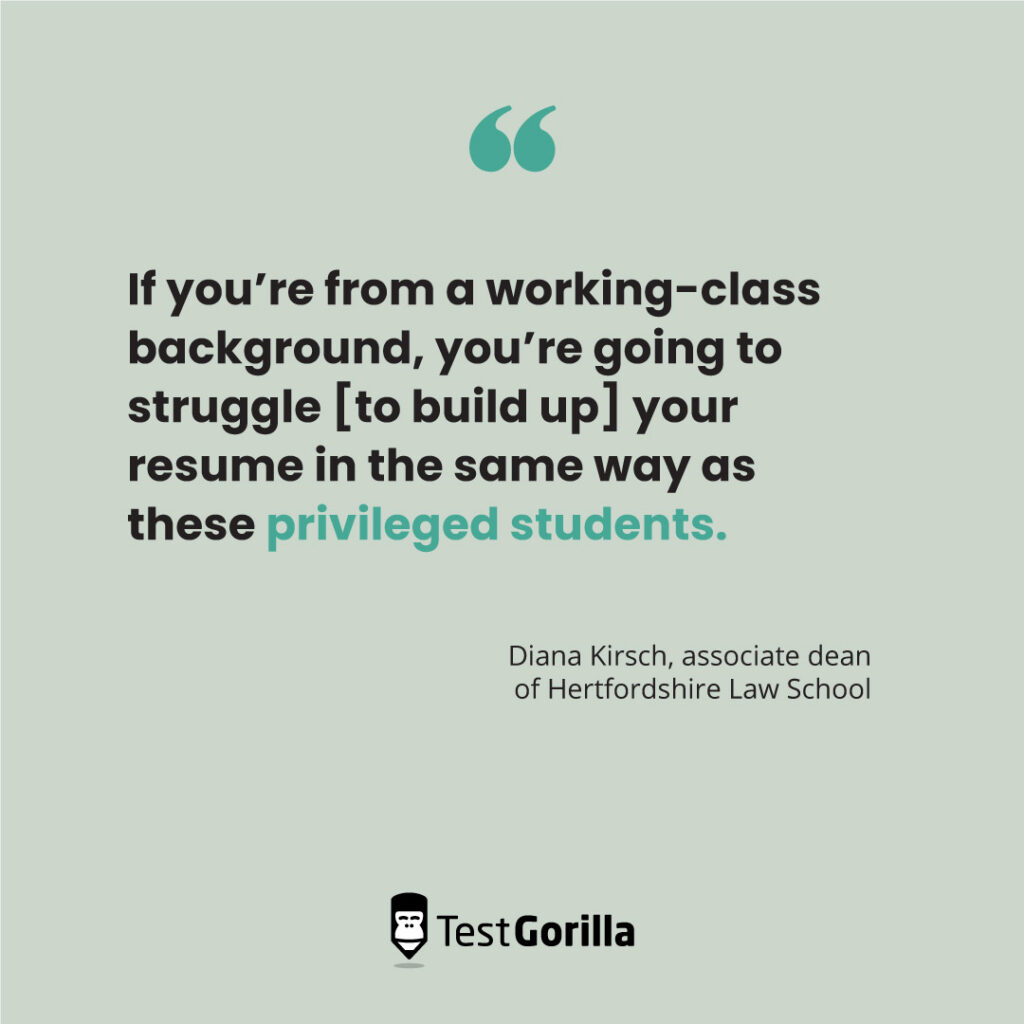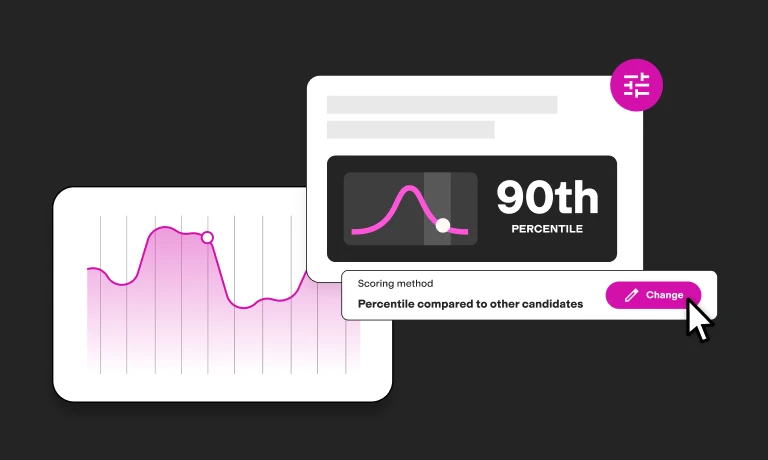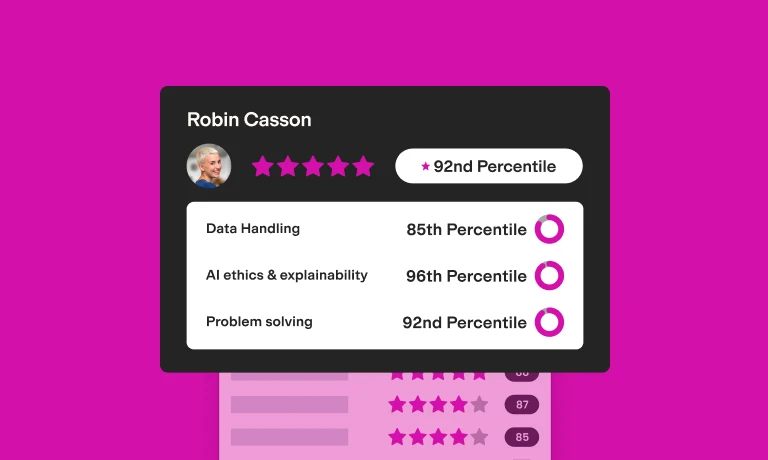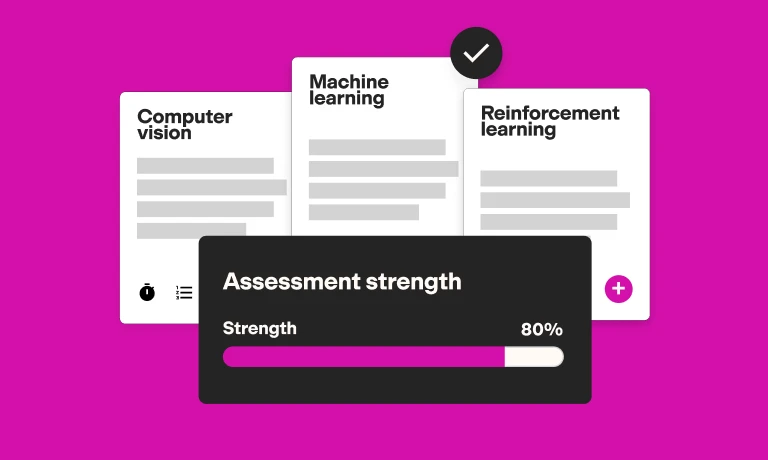Until recently, the legal sector in the UK wasn’t known for its diversity. But in the past few years, it’s been challenging traditional hiring methods and seeking talent from across the country and from a wide range of backgrounds.
One of the most important steps toward this transformation is adopting unbiased hiring practices, like using blind resumes and inclusive language in job descriptions, and placing less emphasis on students attaining top grades from top universities.
According to our 2022 State of Skills-based Hiring Report, 76% of employers across the UK, US, Canada, New Zealand, and Australia use competency-based recruitment to identify and recruit talent**. 91% of these companies are seeing an increase in workplace diversity.**
So what does this mean for the legal industry?
In this piece, we look at the state of diversity and inclusion in the law sector and how firms are changing the way they hire. We also look at what these firms can teach us about skills-based hiring practices – so we can all be part of the change.
Out with the old, in with the new
Nearly half (48%) of the British population picture someone who works in the legal industry to be white – a quarter of them expect legal professionals to be male.****[1]
That’s because institutional barriers have made it challenging for individuals from diverse backgrounds to enter and succeed in the profession.
Many students from underrepresented groups struggle to land training contracts, particularly in larger, city law firms, because the offices recruit from a very narrow pool of students. Students from more privileged backgrounds, on the other hand, have traditionally had a leg up due to their financial statuses. They’re more likely to have connections in firms, and to have completed summer vacation placements or volunteered on real-life projects.
If you’re from a working-class background, you’re going to struggle [to build up] your resume in the same way as these privileged students.
Diana Kirsch, associate dean of Hertfordshire Law School
However, in recent years there’s been growing recognition of the need to challenge the make-up of graduate trainees and promote diversity and inclusion in the legal sector.
Here’s how some firms made the leap from being some of the most elitist firms in the UK to some of the most inclusive.
How law firms are changing the way they hire
While there’s still much work to be done, there’s reason to be positive about the way the legal industry has improved diversity, promoted inclusion, and tackled discrimination.
Let’s take a look at what some UK law firms have done to change the way they hire, and how you can apply those practices to your business – regardless of your industry or location.
1. Creating comprehensive D&I policies
Diversity and inclusion (D&I) initiatives give your business a competitive advantage in worker performance. Diverse and inclusive organizations are more creative, innovative, and effective than homogeneous teams. They’re also better able to serve the needs of a diverse client base, which makes them more likely to capture new markets.
Browne Jacobson, a leading UK law firm, has implemented several D&I policies to foster a culture of inclusivity and respect, and help everyone feel valued and supported.[2] They acknowledge that lasting change in the industry can only be achieved when “jobs at senior levels are accessible to all.” To do that, they’ve set targets to have a minimum of 45% female and 10% UK ethnic minority partners by 2026.
They’re also taking action by:
Supporting greater gender representation and working families. They do this by ensuring promotion processes are equitable and succession planning for key leadership roles. They also develop targeted mentoring and support programs throughout the business to remove barriers to female progression.
Fostering racial and ethnic inclusion. The firm has rolled out mandatory anti-racism training across the firm starting with leadership, launched a mentoring scheme to increase black representation, and continues to publish data (like their 2021 ethnicity pay gap report) to promote transparency.[3]
Championing people with disabilities. They invest in British Sign Language training for key teams, partner with the Business Disability Forum to work towards a “Disability Smart” accreditation, and enhance their Assistive Technology and Workplace Adjustments provisions.
Fostering LGBTQ+ inclusion. The firm observes key dates and campaigns such as LGBTQ+ History Month and Pride Month, hosts internal events to educate the organization around key challenges, and collaborates with some clients to be one of the founding partners of the “East Midlands LGBTQ+ Alliance network.” This network brings together local LGBTQ+ communities and supports those whose organizations don’t have any professional networks to support their LGBTQ+ colleagues.
Here are some ways you can learn from Browne Jacobson’s policies and develop a D&I strategy for your organization, regardless of your industry:
Create a core statement outlining what D&I means to your company and the steps you will take to implement it.
Set measurable goals and targets for recruiting particular cohorts. For example, you could hire more ethnic minorities, applicants with disabilities, or individuals skilled by alternative routes (STARs).
Use a pre-employment assessment platform to better understand your candidates’ skill sets. By doing this, you’ll be able to hire candidates based on their skills and aptitudes. Transparency is key when using this information.
Educate all employees about unconscious bias in a company-wide training program.
Promote psychological safety for people of color (POC), women, and LGBTQ+ workers, and offer mental health-related benefits like therapy.
2. Adopting inclusive language in job descriptions
By using language that’s free from bias and promotes diversity, law firms hire more objectively and fairly, building a more diverse and inclusive workplace.
That’s because inclusive language creates a welcoming and non-discriminatory environment for all job applicants, regardless of personal characteristics.
It can also remove stereotypes and preconceptions about the ideal candidate for a particular role. For example, avoiding gendered language, such as “he” or “she,” signals that people of all genders are welcome to apply. The same applies to not using gender-coded words like strong, assertive, tackle, or driven.
Clifford Chance uses AI tools to eliminate non-inclusive language from their legal documents.[4][5] Similarly, a firm called Freshfields Bruckhaus Deringer removed their “Dear Sirs” salutation from their correspondence, which was used regardless of the recipient’s gender.[6]
Freshfields also does a great job of emphasizing its desire for diverse candidates in its job postings. Here’s a line taken from a recent Dispute Resolution Associate job description: “Freshfields is an equal opportunities employer and all applications received by the firm will be considered by the firm on the basis of their merit alone and we welcome applications from all suitably qualified individuals regardless of background”.
Here are some of the ways you can create inclusive job ads:
Include a D&I statement in all job postings to emphasize your organization’s inclusive hiring policy and that you especially welcome applicants from diverse backgrounds.
Use tools like Diversifier or Textio to make sure your job ads use inclusive language.
Use different types of media (like audio and video) to make sure job postings are accessible to everybody. Make sure to include closed captions on all visual media to make them available to deaf and hard-of-hearing individuals.
Be clear and concise about what the job entails and what qualifications you require. Make the language easy to understand and free of jargon.
Focus on skills instead of years of experience. This can help attract a more diverse pool of applicants. It’s also more beneficial to people from minority backgrounds or lower socioeconomic statuses, as they’re less likely to have degrees from elite universities.
3. Using blind resumes
In the seminal study “Are Emily and Greg more employable than Lakisha and Jamal?” researchers found candidates with White American-sounding names got 50% more invitations to interviews than those with African American-sounding names and identical resumes.[7]
Using blind resumes levels the playing field by keeping the candidate’s gender and demographic information hidden, helping to prevent hiring bias.
Clifford Chance is one of the UK-based law firms that’s leading the change towards fairer, more objective hiring practices. Since 2013, it’s been using blind resumes for its graduate training program to fairly benchmark candidates based on skills-based criteria over academic requirements. And in 2017, it removed minimum academic requirements for their roles.
For well over a decade, the firm’s been running an annual essay competition for law students and trainee solicitors.[8] This competition is designed to encourage young legal professionals to think critically about key legal and social issues, and to express their views and ideas through writing.
The program is open to participants from around the world, and winners are often awarded prizes such as internships or other opportunities to gain valuable experience within the legal profession. This allows the firm to access a broader pool of candidates while giving applicants with unconventional journeys or experiences an unbiased opportunity.
Diana Kirsch, who taught Clifford Chance students at BPP Law School, says: “The competition made a noticeable difference. The Clifford Chance students were a very high-achieving cohort and more likely to be from less traditional, more diverse, backgrounds.”
So, how can you roll out blind resumes in your hiring process?
Refer to your specific D&I mission statement, and determine what criteria your hiring teams need and don’t need to see. For example, a list of existing and transferable skills is helpful, while a person’s education history or location is less so.
Provide training to your HR teams to help them spot value add and culture add from resumes with less candidate information.
Use tools like Entelo to help you source candidates from underrepresented groups based on their skills, not their resumes.
If your budget is limited, you can export candidate information into a Google Sheet and delete or hide certain columns, like names and addresses, to ensure a blind evaluation.
4. Placing less emphasis on grades
Grades alone don’t always accurately reflect a candidate’s potential. Other factors, such as experience, hard and soft skills, and personality, can be more important.
Linklaters is one UK legal firm that still considers A-level, or equivalent, results – but uses a contextual information tool during the application process to understand the context in which applicants attained their results.[9] When applying, candidates can include extenuating circumstances, like illness or bereavement, to provide more context.
Another example is Slaughter and May, which has also changed its recruitment process to put less emphasis on grades. For example, the firm doesn’t have a minimum requirement of “Good” for A-level results anymore.
According to them, “All applications are welcome and will be reviewed by our recruitment partners based on their own merits. Slaughter and May is committed to ensuring that our recruitment processes are barrier-free and as inclusive as possible to everyone.”[10]
These changes in the hiring process at UK legal firms demonstrate a move away from traditional recruitment methods and a recognition that grades are not the only indicator of a candidate’s suitability for a role. By focusing on a broader range of factors, legal firms are able to attract a more diverse pool of candidates and create a more inclusive and dynamic workplace.
Want to learn more about how other countries utilize skills-based hiring practices to deemphasize grade and degree requirements? Check out our guide to skills-based hiring around the world.
5. Providing mentoring opportunities
Mentoring programs help you support and develop individuals from underrepresented groups, giving them the skills and guidance they need to succeed in their careers. This can bring a new range of perspectives and ideas to the table, and create a more diverse and dynamic workplace.
Browne Jacobson is one of the firms that’s implementing this practice most positively. It provides a six-month, 1:1 mentoring program with lawyer members of its REACH (Race, Ethnicity, and Cultural Heritage) community. It also offers two weeks of paid work experience at one of the firm’s five offices.[11]
By offering students a combination of mentoring and real-life work experience, this firm helps them both expand their network and populate their resume. The mentors at Browne Jacobson represent a variety of legal sectors, career levels, and backgrounds. This ensures every student in the program can benefit from it, regardless of their background or personal circumstances.
According to Diana Kirsch, “One of the big barriers to getting a training contract is that many students from widening access backgrounds don’t have time to do unpaid internships. They’re busy working multiple shifts to combat the cost of living crisis.” That’s why, she notes, Browne Jacobson’s paid internship initiative is highly beneficial for students looking for professional development opportunities.
One thing that can help, she says, is when universities help students build up their resumes with the chance to work at their own law clinic. This is something that Hertfordshire Law School offers – and that students can fit around their studies and jobs.
Continuing improvements in diversity in law firms means there will be more senior lawyers in the future, from a wide range of backgrounds, who can mentor new graduate trainees. It’s a virtuous cycle.
The best insights on HR and recruitment, delivered to your inbox.
Biweekly updates. No spam. Unsubscribe any time.
The verdict is in: What UK law firms teach us about skills-based hiring practices
In the past decade, a number of legal firms in the UK have recognized the increasing need for promoting diversity and inclusion in the legal sector. Among the firms leading the transformation are Browne Jacobson, Clifford Chance, Freshfields Bruckhaus Deringer, Slaughter and May, and Linklaters.
These diversity pioneers are tackling the lack of inclusion by implementing initiatives aimed at attracting, retaining, and promoting individuals from various backgrounds. And the shift in recruitment practices not only benefits the firms themselves but also creates a more just and equitable legal system for clients. They include adopting skills-based hiring practices, providing mentorship opportunities, and creating comprehensive D&I policies.
This skills-based approach focuses on the competencies and abilities of candidates rather than traditional markers such as gender, race, education, or social connections, which have historically limited access to the legal profession.
There is still a long way to go to achieve true diversity and inclusion in the legal industry. And the recruitment process is just one aspect of a much larger effort to make the sector more accessible and welcoming to people from all backgrounds.
Skills-based hiring practices are a big step in the right direction – and if UK law firms are able to make this change, then it can be done anywhere.
Want a more effective way to hire diverse talent? Find out how skills-based hiring can help you build happier and more productive teams from a wide talent pool Download the 2022 State of Skills-based Hiring report to learn more.
Sources
“Is this the face of the legal industry? Half of Brits assume someone working in law will be white.” The University of Law. Retrieved February 10, 2023. https://www.law.ac.uk/about/press-releases/assumed-face-of-law/
“Diversity and Inclusion.” Browne Jacobson. Retrieved February 10, 2023. https://www.brownejacobson.com/about/diversity-and-inclusion
“Pay gap report, April 2021.” Browne Jacobson. Retrieved February 10, 2023. https://www.brownejacobson.com/about/legal-notices/pay-gap-reports/2021
“How we hire.” Clifford Chance. Retrieved February 10, 2023. https://careers.cliffordchance.com/london/apply-now/how-we-hire.html
“Top city law firm purges gendered language templates.” Daily Mail. Retrieved February 10, 2023. https://www.dailymail.co.uk/news/article-9037321/Top-City-law-firm-purge-gendered-language-templates.html
“Freshfields Bruckhaus Deringer.” Freshfields Bruckhaus Deringer. Retrieved February 10, 2023. https://www.freshfields.com/
“Are Emily and Greg More Employable than Lakisha and Jamal? A Field Experiment on Labor Market Discrimination.” NBER. Retrieved February 10, 2023. https://www.nber.org/papers/w9873
“Intelligent Aid Essay Competition.” Clifford Chance. Retrieved February 10, 2023. https://www.cliffordchance.com/content/dam/cliffordchance/briefings/2015/04/intelligent-aid-essay-competition-2015.pdf
“Early careers.” Linklaters. Retrieved February 10, 2023. https://careers.linklaters.com/en/early-careers/your-application
“Apply.” Slaughter and May. Retrieved February 10, 2023. https://www.slaughterandmay.com/careers/trainee-solicitors/apply/
“Browne Jacobson launches dedicated Black lawyers mentoring scheme to further improve diversity.” Browne Jacobson. Retrieved February 10, 2023. https://www.brownejacobson.com/about/news-media/launches-dedicated-black-lawyers-mentoring-scheme
Related posts
You've scrolled this far
Why not try TestGorilla for free, and see what happens when you put skills first.
















